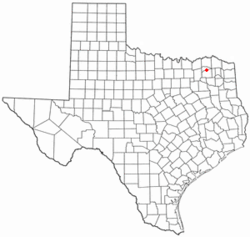world.wikisort.org - USA
Tira is a town in Hopkins County, Texas, United States. The population was 297 at the 2010 census.[5]
Tira, Texas | |
|---|---|
Town | |
 Location of Tira, Texas | |
 | |
| Coordinates: 33°19′36″N 95°34′11″W | |
| Country | United States |
| State | Texas |
| County | Hopkins |
| Area | |
| • Total | 1.44 sq mi (3.73 km2) |
| • Land | 1.42 sq mi (3.67 km2) |
| • Water | 0.02 sq mi (0.06 km2) |
| Elevation | 469 ft (143 m) |
| Population (2010) | |
| • Total | 297 |
| • Estimate (2019)[3] | 313 |
| • Density | 220.73/sq mi (85.23/km2) |
| Time zone | UTC-6 (Central (CST)) |
| • Summer (DST) | UTC-5 (CDT) |
| ZIP code | 75482 |
| FIPS code | 48-73124[4] |
| GNIS feature ID | 1380666[2] |
Geography
Tira is located in northern Hopkins County at 33°19′36″N 95°34′11″W (33.326629, –95.569853).[6] Texas State Highway 19 runs through the western part of the town, leading north 25 miles (40 km) to Paris and south 13 miles (21 km) to Sulphur Springs, the Hopkins county seat. Tira is 1 mile (1.6 km) east of the dam at the outlet of Jim Chapman Lake (formerly known as Cooper Lake) and is 9 miles (14 km) by road northeast of the South Sulphur Unit of Cooper Lake State Park.
According to the United States Census Bureau, the town has a total area of 1.4 square miles (3.7 km2), of which 0.02 square miles (0.06 km2), or 1.65%, are water.[5]
Demographics
| Historical population | |||
|---|---|---|---|
| Census | Pop. | %± | |
| 1980 | 249 | — | |
| 1990 | 237 | −4.8% | |
| 2000 | 248 | 4.6% | |
| 2010 | 297 | 19.8% | |
| 2019 (est.) | 313 | [3] | 5.4% |
| U.S. Decennial Census[7] | |||
2020 census
| Race | Number | Percentage |
|---|---|---|
| White (NH) | 274 | 85.89% |
| Black or African American (NH) | 9 | 2.82% |
| Native American or Alaska Native (NH) | 2 | 0.63% |
| Asian (NH) | 1 | 0.31% |
| Mixed/Multi-Racial (NH) | 10 | 3.13% |
| Hispanic or Latino | 23 | 7.21% |
| Total | 319 |
As of the 2020 United States census, there were 319 people, 115 households, and 80 families residing in the town.
2000 census
As of the census[4] of 2000, there were 248 people, 102 households, and 75 families residing in the town. The population density was 172.4 people per square mile (66.5/km2). There were 117 housing units at an average density of 81.3 per square mile (31.4/km2). The racial makeup of the town was 96.37% White, 2.02% from other races, and 1.61% from two or more races. Hispanic or Latino of any race were 0.81% of the population.
There were 102 households, out of which 25.5% had children under the age of 18 living with them, 65.7% were married couples living together, 5.9% had a female householder with no husband present, and 25.5% were non-families. 20.6% of all households were made up of individuals, and 15.7% had someone living alone who was 65 years of age or older. The average household size was 2.43 and the average family size was 2.84.
In the town, the population was spread out, with 21.4% under the age of 18, 4.4% from 18 to 24, 21.0% from 25 to 44, 30.2% from 45 to 64, and 23.0% who were 65 years of age or older. The median age was 46 years. For every 100 females, there were 105.0 males. For every 100 females age 18 and over, there were 97.0 males.
The median income for a household in the town was $36,964, and the median income for a family was $47,639. Males had a median income of $27,500 versus $16,806 for females. The per capita income for the town was $18,750. About 4.7% of families and 5.8% of the population were below the poverty line, including 3.2% of those under the age of eighteen and 15.3% of those 65 or over.
Education
Tira is served by the North Hopkins Independent School District.
References
- "2019 U.S. Gazetteer Files". United States Census Bureau. Retrieved August 7, 2020.
- U.S. Geological Survey Geographic Names Information System: Tira, Texas
- "Population and Housing Unit Estimates". United States Census Bureau. May 24, 2020. Retrieved May 27, 2020.
- "U.S. Census website". United States Census Bureau. Retrieved 2008-01-31.
- "Geographic Identifiers: 2010 Census Summary File 1 (G001): Tira town, Texas". American Factfinder. U.S. Census Bureau. Archived from the original on February 13, 2020. Retrieved March 15, 2018.
- "US Gazetteer files: 2010, 2000, and 1990". United States Census Bureau. 2011-02-12. Retrieved 2011-04-23.
- "Census of Population and Housing". Census.gov. Retrieved June 4, 2015.
- "Explore Census Data". data.census.gov. Retrieved 2022-05-22.
- https://www.census.gov/ [not specific enough to verify]
- "About the Hispanic Population and its Origin". www.census.gov. Retrieved 18 May 2022.
Другой контент может иметь иную лицензию. Перед использованием материалов сайта WikiSort.org внимательно изучите правила лицензирования конкретных элементов наполнения сайта.
WikiSort.org - проект по пересортировке и дополнению контента Википедии
